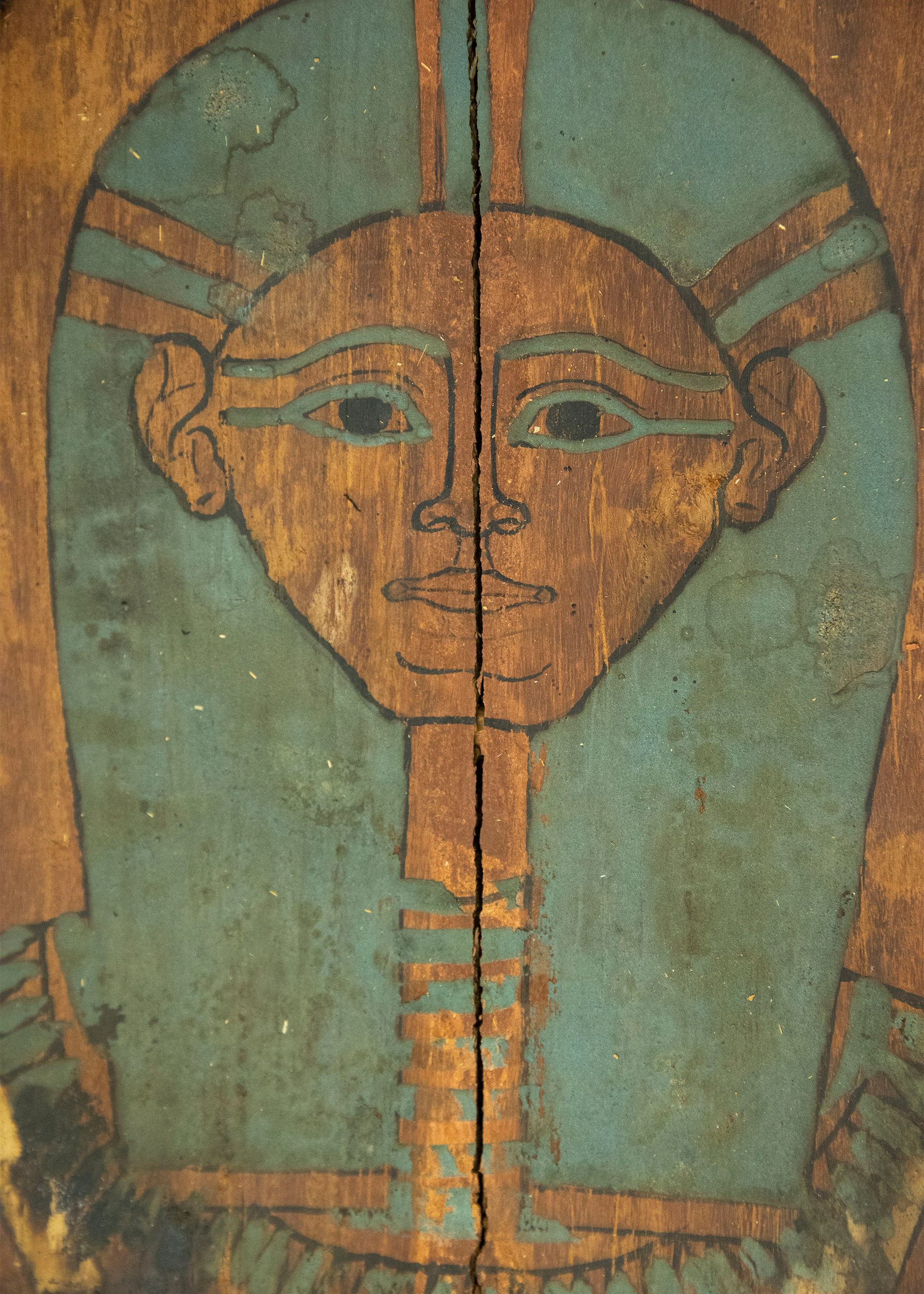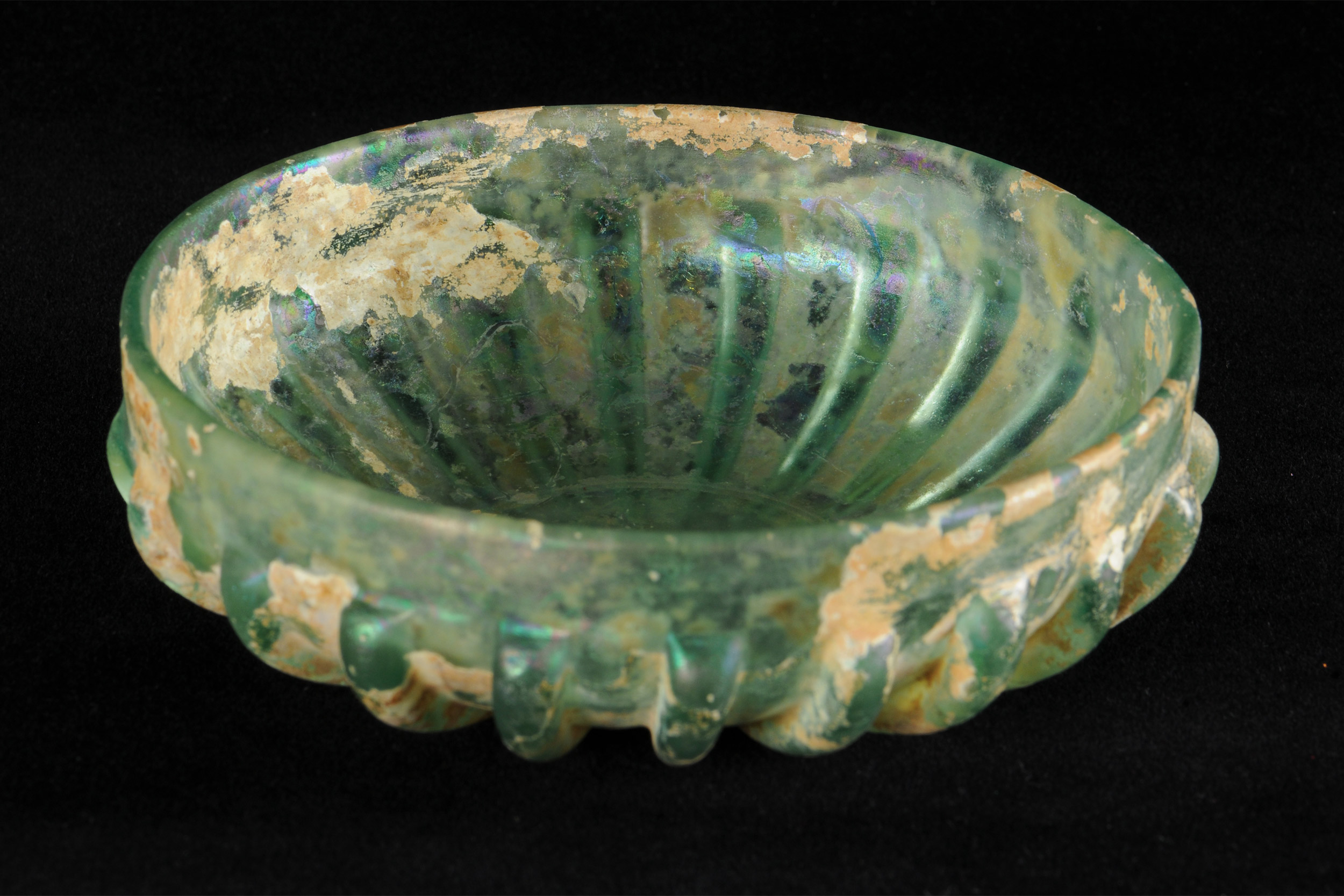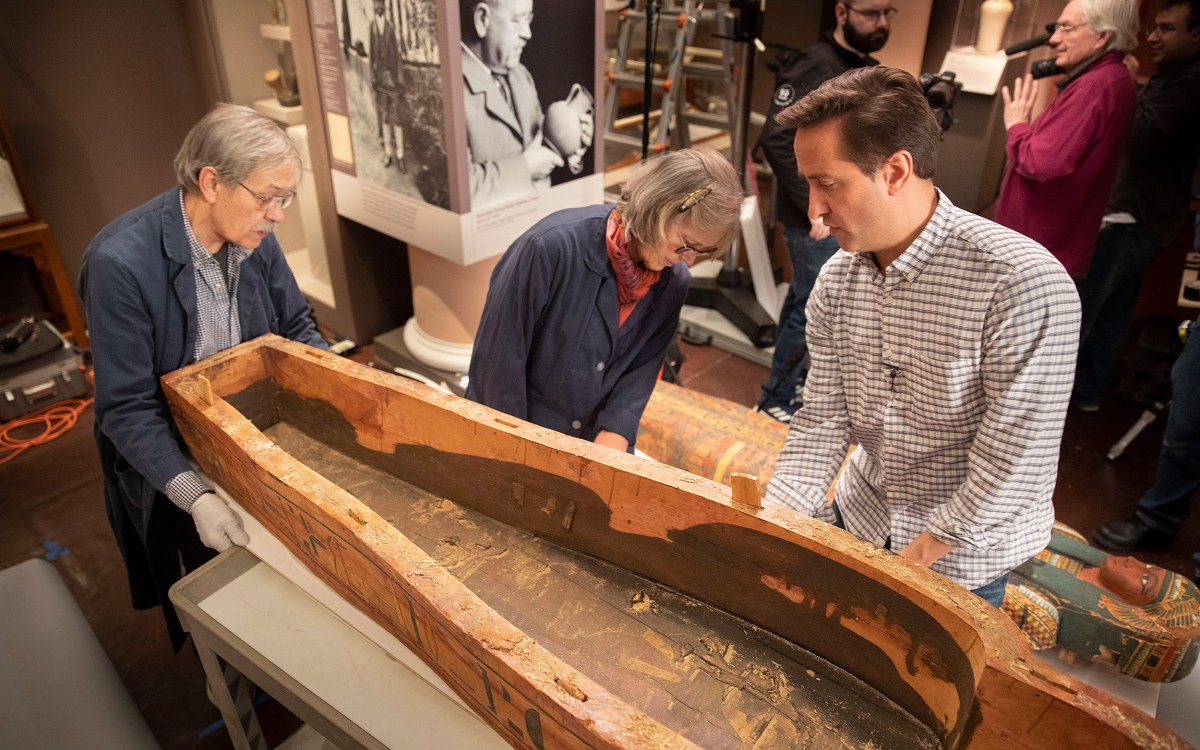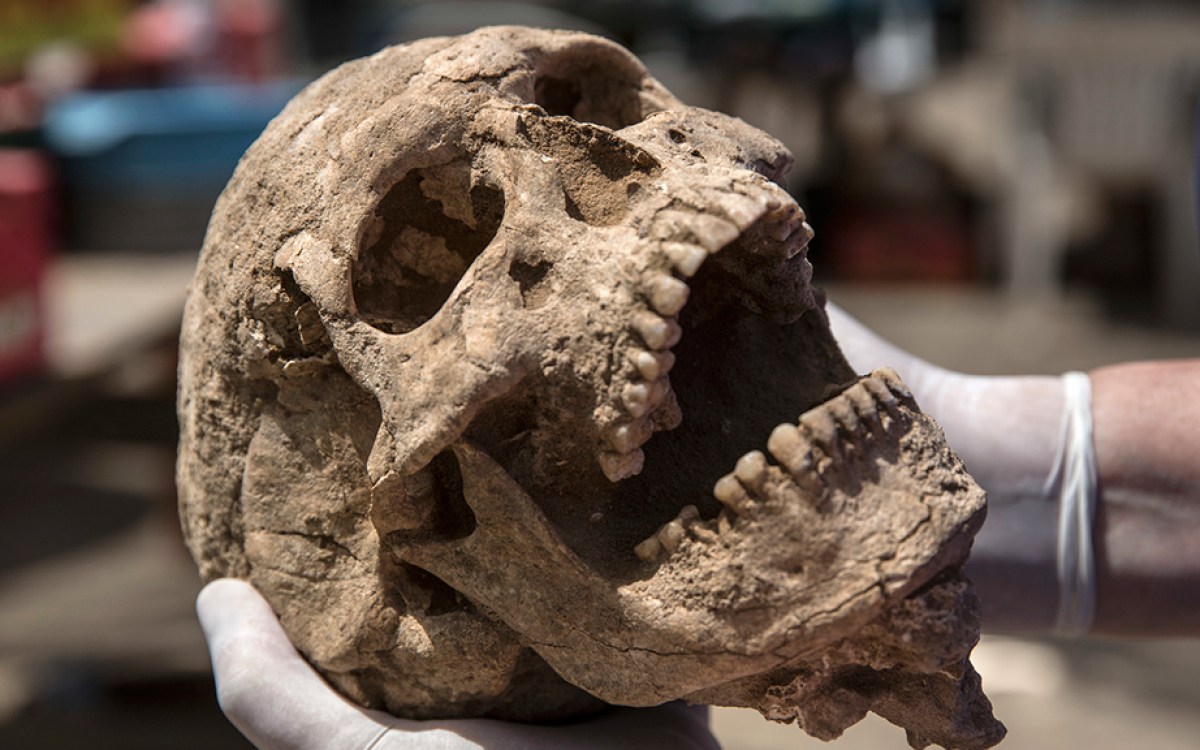A new name for the Semitic Museum
Harvard Museum of the Ancient Near East more ‘accurately reflects the diversity of the collection’

The Semitic Museum’s new name, Harvard Museum of the Ancient Near East, reflects the collections and research conducted there. Pictured is artwork from one of the coffins that came to the museum from modern-day Thebes, Egypt, between 1901 and 1902.
Kris Snibbe/Harvard file photo
The Harvard Semitic Museum has changed its name to the Harvard Museum of the Ancient Near East (HMANE) to better “reflect its core mission in clearer terms,” said Director Peter Der Manuelian. “We wanted a more inclusive and descriptive name, one that accurately reflects the diversity of our collection.” Founded in 1889, the museum was conceived as a teaching tool to study the ancient histories and cultures of people who spoke Semitic languages, among them Israelites, Moabites, Arabs, Babylonians, and Phoenicians. The new HMANE name was a decision years in the making, as Manuelian explained in a chat with the Gazette.
Q&A
Peter Der Manuelian
GAZETTE: What prompted the name change?
MANUELIAN: When the Semitic Museum opened at 6 Divinity in 1903, the name was meant as a blanket term for all the peoples of the ancient Near East who shared the somewhat extended family of “Semitic” languages. Our focus remains on the wide variety of diverse peoples living in the eastern Mediterranean region, parts of modern-day Iraq, and even of north Africa: the ancient Sumerians, Egyptians, Assyrians, Babylonians, Hittites, Philistines, Israelites, Phoenicians, and others.
Our original mission has not changed, but the term “Semitic Museum” is less widely understood in the public domain. People either had no idea what they might see in a “Semitic” museum, or they (incorrectly) believed the museum was exclusively devoted to Jewish exhibitions. Many had heard the word “anti-Semitic” but “Semitic” was less common. The ancient Near East provides the world’s first examples of centralized political authority and written language, with sophisticated science and literature. The social, literary, political, artistic changes and innovations are foundational to global human history. And the region continues to be the basis for modern identities — we can’t understand current political events there in a cultural or historical vacuum.
GAZETTE: Why is the name being changed now?
MANUELIAN: The change is not a reaction to any particular event, but rather our attempt to reflect our core mission in clearer terms. The process took a great deal of time and thought. Over a period of many years, we held discussions with stakeholders and distributed questionnaires about the museum to visitors and others, both on campus and off. We held focus groups, organized discussion dinners with faculty across the Harvard community, from the Faculty of Arts and Sciences to the Law and Business Schools. We even devoted Museum Studies courses to the issue.
Regarding the name, we know that no name is perfect. For example, the “Near East” is not particularly “eastern” to colleagues living on the other side of the world. But in our defense, our building stands in Cambridge, Massachusetts. We considered the term “Middle East” but it tends to refer to modern times more than “Near East” does. And the term “Ancient World” casts the net too far across the globe given the specific collections we have. We ran a range of names by different sectors of the community, gathered opinions, and studied the branding of many like-minded institutions. We believe “Harvard Museum of the Ancient Near East,” or “HMANE” for short, to be the clearest and most inclusive description of what we have and what we do.

From the “Mediterranean Marketplaces” exhibit opening April 5.
Courtesy of Harvard Museum of the Ancient Near East
GAZETTE: Will the museum still feature artifacts and exhibits that celebrate Jewish culture?
MANUELIAN: Absolutely. We have a very engaging and educational full-scale reproduction of a first millennium B.C. house from ancient Israel in our first-floor gallery. It’s a big hit with visiting school groups and archaeology classes; there is nothing quite like it in the area. But the house represents just one of many ancient cultures in our collection. We show objects from ancient Egypt and elsewhere on our second floor, and from Mesopotamia (today’s Iraq and Syria) on our third floor.
GAZETTE: How does the new name align with your vision of the museum’s future?
MANUELIAN: In many ways our mission has not changed. We support the teaching mission of the University and provide a resource on the archaeology and culture of these fascinating ancient civilizations for the Cambridge community and the visiting public from all over the world. We support international scholars in their research as well. We have projects in the works on all three of our gallery floors just now.
GAZETTE: Can you walk us through?
MANUELIAN: Following the reopening of the Harvard museums to the public, we plan to complete a new show called “Mediterranean Marketplaces: Connecting the Ancient World.” This exhibition explores the movement of goods, peoples, and ideas around the ancient Mediterranean region, transforming the livelihoods of people at all levels of society. Just like today, ancient “consumers” were also connected to distant markets. Along with some interactive exhibits, one highlight will be a large cutaway reproduction view of an ancient ship’s hull, filled with some of the antiquities our museum expedition recovered from a Phoenician shipwreck off the Sinai coast in 1999. You will see amphorae [large storage vessels] that still show the barnacles attached after all those centuries underwater.
On our second floor, a very popular augmented reality exhibit, “Dreaming the Sphinx” [accompanied by a free app on the Apple and Google Play stores], is soon to get an update. In addition to translating the ancient Egyptian hieroglyphic stela text, placing the visitor before the giant Sphinx at the Giza Pyramids, and showing the site during three different eras, ancient to modern, version 2.0 will add more time periods plus a reenactment of the story told in the hieroglyphs: how the young prince Thutmose IV napped in the shadow of the Sphinx, who then appeared to him in a dream, and in exchange for being cleared of sand, gave Thutmose the throne.
“The Ancient Near East provides the world’s first examples of centralized political authority and written language, with sophisticated science and literature. The social, literary, political, artistic changes and innovations are foundational to global human history.”
Earlier this year we assembled an all-star cast of specialists and opened our three spectacular ancient Egyptian mummy cases on the second floor. We studied the ancient pigments, residue from the burial ceremonies, ancient wood, and construction techniques, and we did photogrammetry and 3D scanning. This will result in both an exciting interactive exhibit on the coffins (sneak peek at the animated, rotatable models 3D here: https://skfb.ly/6PVBy), and an academic publication (in our “Harvard Egyptological Studies” series) that pools all the new scientific discoveries together.
On our third floor, we will soon breathe new life into our Mesopotamian gallery with “The Art of Intimidation.” Guided by their phone or tablet, visitors will be able to see ancient Assyrian palace reliefs come alive in restored ancient colors and by animating the activities shown, from royal lion hunts to battles. An ancient “palace overseer” avatar will guide you around the gallery.
GAZETTE: Times have changed drastically for museums since the spread of COVID-19. How is your museum addressing this new challenge?
MANUELIAN: We believe we are out in front of many museums in terms of virtual access to our galleries. On the home page of our website we have posted a virtual tour of the entire building. This uses a very versatile format that is perhaps familiar to visitors from real estate websites. It begins with a “dollhouse” view of the Museum, and then the visitor can “jump” inside the building. You can click “play” for an auto-run tour through the museum, or you can navigate and look around freely yourself. And selected objects have “hot spots” that you can click on. These show additional text, photos, and in some cases the hot spots even embed rotatable 3D models of the objects. It’s almost like taking them out the display cases. Examples include our three Egyptian mummy coffins on the second floor and our Assyrian palace reliefs on the third floor.
Our “Dreaming the Sphinx” augmented reality app on the second floor has a downloadable PDF file with two hieroglyphs. Users can aim their phones at the hieroglyphs and most of the same experiences they could have in front of the Egyptian stela in our gallery are available right at home. We expect to add more of these immersive technologies to the museum exhibits in the coming months, and we also look forward to welcoming visitors back into the building when it is safe to do so.
Interview was edited for clarity and length.







